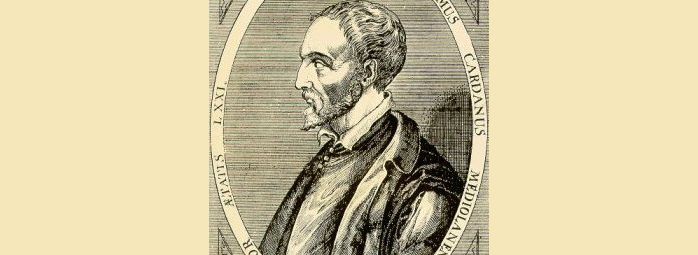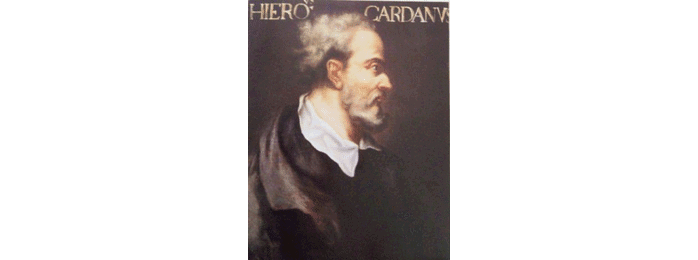
(Gerolamo Cardano; Jerome Cardan)
The information and quotes contained in this story were taken from the book, Doctor Cardano; Physician Extraordinaire by Alan Wykes, published by Frederick Muller Ltd. in 1969.
Gerolamo Cardano was born in the year 1501. He was an inventor, an astrologer, a philosopher and was the first to propound the mathematical theory of probability. He has been referred to as the ‘Gambling Scholar.’
He was skilled in divination by palmistry and geomancy, and he was the first to recognize that much could be told about human character by the study of physiognomy and handwriting. “His own character combined intellectual brilliance, emotional instability – and moral courage.”
He was born illegitimate and unwanted, he survived early setbacks and rose by his own efforts to an almost idolatrous fame, only to fall into misfortune and disrepute over which he seemed to have no control.
Today it is hard to find anyone who has ever head of him, though his name is unwittingly mentioned by aficionados of automobiles every time they refer to the cardan-shaft, a mechanical device he invented.
He was one of the greatest algebraists of his time and called to the service of kings. He researched tuberculosis, asthma, and venereal disease, and by his cure of the asthmatic illness of Archbishop Hamilton, rose to the pinnacle of international fame.
“In medicine, Cardano ranks with Hippocrates, Galen, Maimonides, and other physicians of classical and medieval times. He fought against prejudice and the superstitions that in the dark ages had become associated with the study of physical ills.”
He wrote more than two hundred books on everything that interested him. Many of them were best-sellers during his lifetime and influenced the work of future mathematicians and scientists.
We will mention some of the key aspects of his very unusual life.
After a protracted labor of three days, Cardano was born, unhonored and unwanted, but triumphant over the early efforts of his mother to abort him, on September 24, 1501. His parents were not married.
He was to remark in his autobiography near the end of his life, “sickness of body, and gloom of mind in consequence of some injustice in my tutelage, were my daily companions.” Early in his youth, he contracted the plague, which he survived, but ended up with five typical plague-warts – one on the end of his nose, one on his forehead, one on each cheek, and one on the chin.
He was unwanted by his mother and a succession of paid wet-nurses, who, possibly because of the fear of contracting the plague themselves, completely neglected him. He received frequent whippings from his parents and aunt. It certainly made him an introspective child and led him to the refuge of contemplation, which was a great comfort to him.
“He was what we would call today, accident-prone. He had only to sit upon the threshold of the Cardano lodgings for a stone to work loose from the parapet and fell him into bleeding unconsciousness. More than once he fell down flights of steps – on one occasion letting fly a hammer he was carrying which thereupon described an arc and landed on his skull as he tumbled to the bottom; and he had only to cross a canal for the rail of the bridge to give way and let him down into the water…”
From the age of five, his father made him carry increasing large loads of legal and medical books he needed when visiting his patrons. The boy had strapped a pannier to his back, into which books were stuffed. He also had to carry books in his arms and occasionally upon his head. “From time to time as we walked the streets my father would command me to stop while he opened a book and, using my head as a table, read some long passage, prodding me the while with his foot to keep still if I wearied of the great weight.”
He was ambitious and always looked forward to a brighter future so as to escape his difficult present condition. “I lived to myself; and, in some hope of future things, despised the present… I desire to defend myself from obscurity,” he wrote in a letter.
Cardano’s early studies show that he had interests in a variety of topics, including witchcraft, unicorns, the circulation of the blood, the horoscopes, games with cards and dice, cures for warts and impotence, the ways of animals and birds, architecture, ballistics, and anything else he could discover.
In 1514, he and his father paid a visit to Leonardo da Vinci, who was at the height of his fame, and listened to a discussion of geometry. “My father’s reputation as a scholar was such that he was consulted by superior persons,” he remarked.
Eventually his mother came to love him and fought with his father over Gerolamo’s future education. He and his mother eventually persuaded his father to allow Cardano to enter the study of medicine. Gerolamo would later write, “I began immediately to assess the troubles of my own body and to think what benefits I could confer on mankind by its study and cure.”
He looked for a means of support for himself during his studies at the university. Since he had mastered arithmetic and the first six books of Euclid, was brilliant in dialectics, had a working knowledge of alchemy and astronomy, and was familiar with principal philosophical works, he decided to make money casting horoscopes. He eventually had many clients.
But what was most profitable for him was his skill in gambling. His skill lay in his ability to calculate his chances and bet accordingly. His study of the subject would lead to the propounding of the laws of probability, as we know them today, in his work Liber de ludoaleae (1563). He flourished financially and was able to set aside more than a thousand crowns for his education at the University of Pavia.
During his first academic year, his advancement was so fast that his tutor, Giovanni Targio, allowed him occasionally to teach Euclid. By the time he was twenty-one he was also appointed as a teacher of dialectics and philosophy. Throughout this time he was also writing treatise after treatise on mathematics, geometry, and music.
Gambling, music, and fencing were his only recreations, with gambling taking up the largest part in his daily life. He became the subject of a special mathematical study that was called, The Book on Games of Chance. For this study, he again used the formula he had worked out during the time he prepared to come to the university.
“Gerolamo was never a compulsive gambler. He had no desire to lose or to find orgasmic relief. His interest was not one of psychological necessity, his interest was a scientific one.”
Upon entering his medical studies at Padua University, his tutor was Matthew Curtius, who was professor of medicine at Padua. “So clear was his instruction,” Gerolamo said, “that within a year I was able to present myself to the faculty.” The normal time for the study of medicine was nine terms. In his day, the granting of a degree in medicine depended as much on social qualification as it did upon the proof of an ability in healing. The admission to the medical faculty resembled a committee process to be admitted to an exclusive club.
The group attempted to reject Gerolamo several times at his degree procedure, but after numerous votes throughout the day, he reached his laureate at twenty-five years old.

Also throughout his career, the College of Physicians was continually against him and he had a lifetime of difficulties. In spite of this, he recognized that medicine was his chief love. “Whatever small fame I had achieved in Milan as geometer, astronomer, designer, interpreter of Euclid, astrologer, geographer – this was of less import to me than my true vocation, where my reputation had scarcely begun.”
Because he was disgusted with the actions of the College of Physicians, he decided to deal a swinging blow at the establishment of the College. This could best be done, he thought, by the addition of caustic comments he was prepared to add to his student thesis. In a single week he rewrote and added what was necessary for a new book. His old thesis became a book entitled, On the Bad Practice of Medicine in Common Use.
He gave the manuscript to a friend, Ottaviano Scoto, who was a student he had befriended at Pavia. Scoto promised to get the book out quickly and personally do the proofreading to save time.
The book was published in 1536, and was an immediate success so far as the ordinary public was concerned. For a doctor to pick fault with his colleagues gave the lay reader a sense of identification, a feeling that here was an insider, a spokesman who was putting into words the very doubts that the plain man invariably felt when faced with the opinions of medical practitioners; men who surrounded themselves with impenetrable mysteries and could cure no one without consulting others of their kin, who also demanded fees for their contributions.
The common medical practices that Cardano vehemently denounced were seventy-two in number. He attacked the premise that in every case of illness immediate recourse should be had to powders and potions. “To do nothing with physic is far better than to do too much, and a physician desiring to act rightly should consider a great number of things before setting down prescriptions for the pharmacist to manufacture.” He denounced other practices, “the result of the tribal insecurities of men who banded themselves together and showed to the world a surface of pomp and learning that satisfactorily concealed from the beholders the depth of ignorance beneath.”
The book immediately arose the violent antagonism of the College of Physicians. But he had himself put into his enemies’; hands the very weapon to defend themselves. Haste on his part to get the book rewritten, and the absence of opportunity to correct the proofs, had resulted in barbarous errors of grammar and syntax, as well as errors of fact. “I blush to acknowledge that there were more than even three hundred blunders of mine in this book, exclusive of misprints,” he would later say.
The results were devastating for Cardano. The College of Physicians pointed out that this man did not even have his own practice and was excluded from the College. His treatments, they said, would place people in danger. Here is a man who could not even express himself intelligently; how could he treat those who were ill!
Now in the depths of depression, good news arrived. Cardano had surreptitiously treated a patient, who had now fully recovered and was offering an official appointment. The patient was Francesco Gaddi, Prior of the order of Augustinian Friars in Milan. He had suffered from a scrofulous infection which was most probably tuberculoid leprosy. Treatments at the time, if given at all, were branding the patches on the skin with hot irons.
Cardano’s treatment of the Prior had been simple and completely untrammeled by medicaments. Upon consideration of the patient’s mode of life, which involved complete neglect of all bodily needs in the cause of spiritual dedication, he arrived at the common sense conclusion that no cure could be effected on a dirty, undernourished body. He prescribed regular hours of sleep and exercise, frequent bathing, the wearing of linen instead of sackcloth next to the skin, and a reasonable diet of fish and wine.
The Prior had taken Cardano’s advice, and had so recovered the health of his body that it had resisted the further attacks of the disease, which had completely withdrawn and left his skin clear and whole. Now he wished to appoint Cardano as official physician to the Priory in acknowledgment of his skill.
Other successes were often remarkable. Martha Mott, who for thirteen years had suffered from an ulcerated leg and was bedridden, was cured and restored to health. Cardano helped many people suffering with tuberculosis with sound health programs, utilizing fresh air and exercise. He would establish the principle of the sanatorium – which was to be rediscovered three hundred years later.
Cardano helped those afflicted with syphilis and gonorrhea, and worked with famous, high-profile religious leaders who suffered from asthma and other afflictions that no one else could cure.
But further troubles came from his own three children, who were always troubled and difficult for him to handle. Due to their wild and crazy actions, they destroyed his reputation and people refused to associate with him. One son was imprisoned and beheaded for attempting to poison his wife soon after childbirth.
In 1570, Cardano was arrested and tried by the Inquistion. His crime was casting and publishing a horoscope of Christ. He was imprisoned for several weeks, not knowing what his fate would be. He was in serious trouble, but he remembered the words of John Hamilton, Archbishop of St. Andrews in Scotland, who he had cured of asthma. The Archbishop told him to call upon him in any circumstance in which is gratitude could be expressed.
The Archbishop was able to win his release by sending a special emissary to Rome with the words, “For he is a scholar who troubles only with preserving and curing the bodies in which God’s souls may live to their greatest length.”
In his last days in Rome, he walked with the strange, undirected gait of a lunatic. A lifelong believer in astrology, Cardano accurately predicted his life would end at age 75. He achieved this feat by committing suicide on September 21, 1576, “a man not without greatness in an age of great and cruel men.”
